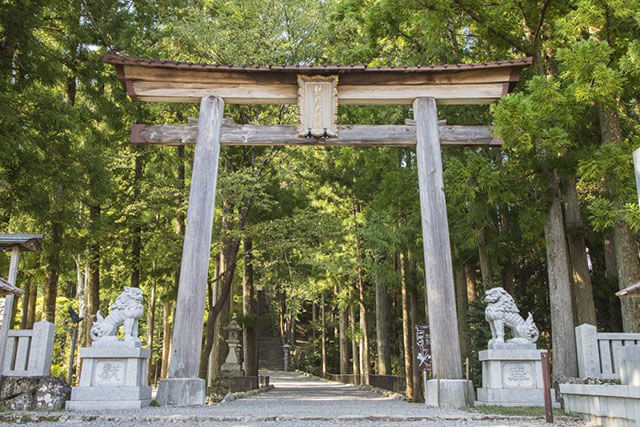
Located right in the heart of the Kumano Kodo network of pilgrimage routes sits Kumano Hongu Taisha shrine, one of Kumano’s three most important shrines. The shrine itself is well worth a visit; however, for those looking to explore Wakayama’s natural beauty and spiritual history a little more deeply, there’s plenty more to uncover. From mouth-watering local cuisine to one-of-a-kind onsen towns, an exploration of the Kumano Hongu Taisha area is an unforgettable experience. Here’s a guide on where to begin.
-
01
Guest House: Reimei
![]()
It’s said that the best way to really appreciate the culture of a city is through its food, and there’s no better way to start your Kumano adventure than with a visit to Reimei. A humble but much-loved Chinese restaurant, Reimei is famous for its “Kumano Gyu Gyoza,” a local specialty stuffed to the seams with delicious Kumano beef and fried to crisp perfection. If gyoza isn’t to your taste, the restaurant also serves plenty of other Japanese-Chinese style dishes, including ramen and karaage (fried chicken). Reimei is open from 10 am - 2 pm for lunch service and 4:30 pm - 8 pm for dinner service seven days a week.
- 熊野古道の宿・れいめい
-
-
- 和歌山県田辺市本宮町請川302-1
-
-
-
- 0735420165
-
View All
-
02
Kumano Hongu Taisha Shrine
![]()
Kumano Hongu Taisha is as architecturally impressive as it is spiritually significant, making it one of the more popular stops along the Kumano Kodo pilgrimage routes. The long stone staircase leading up to the grounds of the shrine is surrounded by towering cedar and cypress trees, enshrouding the area in an air of almost mystical reverence and natural tranquility. Well worth putting aside a little extra time to explore, Kumano Hongu Taisha is the chief shrine of some 3,000 Kumano shrines dotted across Japan.
- Kumano Hongu Taisha shrine
-
-
- Wakayama Pref. Tanabeshi Honguchouhongu
-
-
-
- 0735420009
-
View All
-
03
Oyunohara (former shrine ground)
![]()
A 10-minute walk south of Kumano Hongu Taisha, Oyunohara is one of the Kumano area’s most striking sights. Although it was once home to Kumano Hongu Taisha, today just two small stone shrines remain, standing as defiant remnants of the original structure. The location is a photographer’s delight, as the foliage-rich surroundings transform with the passing seasons. In summer expect fields of vivid green and in spring the gate is surrounded by soft pink cherry blossoms, while the arrival of November brings with it a smattering of fiery red and orange autumn leaves. The site is also famous as a spot of spiritual power, making it a magnet for those looking to recharge their spiritual energy.
- Oyunohara
-
-
- Wakayama Pref. Tanabeshi Honguchouhongu
-
-
-
- 0735420735
-
View All
-
04
Kawayu Onsen
![]()
Running along the Oto River, Kawayu is a popular onsen town and home to some of the most unique bathing facilities in Japan. Kawayu has a number of permanent baths, but to really make the most of the naturally heated, crystal clear, hot spring water, visitors are encouraged to try digging their own in the riverbanks. If you’re weary from days of pilgrimage trekking, it’s an excellent place to stop for a night or two. Along the north side of the river, you’ll find plenty of ryokans, hotels, and minshukus (Japanese-style bed and breakfasts). Unfortunately, the 2018 summer typhoon season destroyed some of the area’s onsen baths, but they’re currently under repair and are expected to be back to their former glory by 2019.
-
05
Yunomine Onsen
![]()
If you haven’t had enough onsen soaking in Kawayu, then make the trip to Yunomine Onsen, a tranquil hot spring town that’s home to a World Heritage bath. Tucked in a forest-flanked valley deep in the mountains of the Kumano Kodo, Yunomine Onsen was a regular rest spot for pilgrims, who would stop and bathe enroute to Hongu Grand Shrine. Located in a bathhouse by Yunomine Creek, the World Heritage recognized Tsubo-yu is the town’s most popular bath. If you want to try it for yourself, be prepared to wait as the bath fits only two people at a time.
While you are waiting you can always try the local specialty: onsen eggs slow-cooked in the natural hot spring water. If you have a little time (around 45 minutes or so) you can also try cooking a sweet potato on the hot stone plates near the onsen egg basin. Food and seasonings are all available near the cooking site.- 湯の峰温泉
-
-
- 和歌山県田辺市本宮町湯峯
-
-
-
- 0735420735
-
View All




 Go here
Go here






